by Eric Meier
When attempting to identify a wood sample, it’s important to keep in mind the limitations and obstacles that are present in our task. Before starting, please have a look at The Truth Behind Wood Identification to approach the task in a proper mindset; I consider the linked article to be required reading for all those visiting my site with the intent of identifying wood.
1. Confirm it is actually solid wood.
Before proceeding too much farther into the remaining steps, it’s first necessary to confirm that the material in question is actually a solid piece of wood, and not a man-made composite or piece of plastic made to imitate wood.
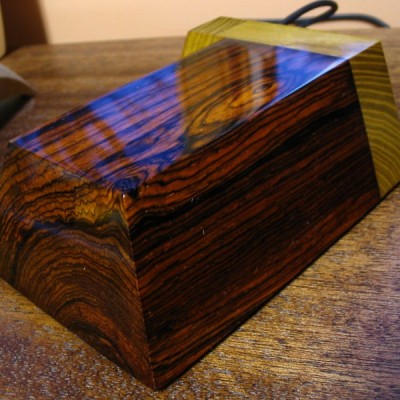
Can you see the end-grain?
Manufactured wood such as MDF, OSB, and particleboard all have a distinct look that is—in nearly all cases—easily distinguishable from the endgrain of real wood. Look for growth rings—formed by the yearly growth of a tree—which will be a dead-giveaway that the wood sample in question is a solid, genuine chunk of wood taken from a tree.
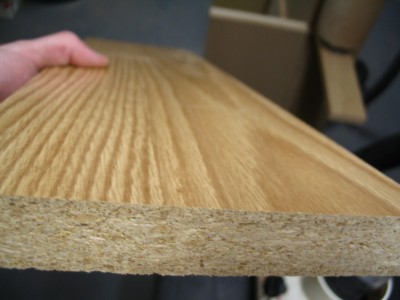
Is it veneered?
If you see a large panel that has a repeating grain pattern, it may be a veneer. In such cases, a very thin layer of real wood is peeled from a tree and attached to a substrate; sometimes the veneer can be one continuous repeating piece because it is rotary-sliced to shave off the veneer layer as the tree trunk is spun by machines. Assuming it is a real wood veneer with a distinct grain and texture—and not merely a piece of printed plastic—you may still be able to identify the outer veneer wood in question, but you should still realize that is it only a veneer and not a solid piece of wood.
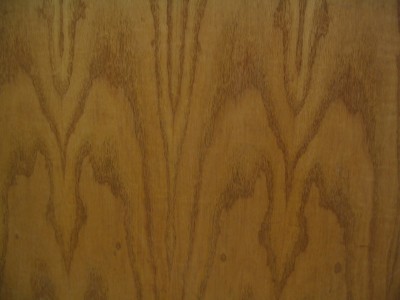
Is it painted or printed to look like wood?
Many times, especially on medium to large-sized flat panels for furniture, a piece of particleboard or MDF is either laminated with a piece of wood-colored plastic, or simply painted to look like wood grain. Many of today’s interior hardwood flooring planks are good examples of these pseudo-wood products: they are essentially a man-made material made of sawdust, glues, resins, and durable plastics.
2. Look at the color.
Some questions to immediately ask yourself:
Is the color of the wood natural, or is it stained?
If there is even a chance that the color isn’t natural, the odds are increased that the entire effort of identifying the wood will be in vain.
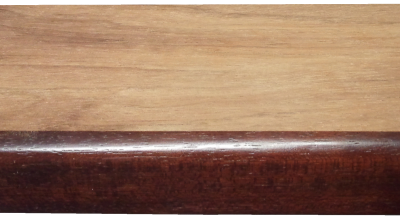
Is it weathered or have a patina?
Many woods, when left outside in the elements, tend to turn a bland gray color. Also, even interior wood also takes on a patina as it ages: some woods get darker, or redder, and some even get lighter or lose their color; but for the most part, wood tends to darken with age.
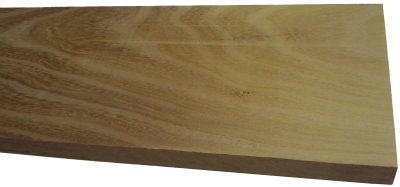
Is it possible to sand or plane the board to see the natural raw color of the wood?
The most predictable baseline to use when identifying wood is in a freshly sanded state. This eliminates the chances of a stain or natural aging skewing the color diagnosis of the wood.
3. Observe the wood grain.
If the wood is unfinished, then look at the texture of the grain. Ask yourself these questions:
Does the wood have an open, porous texture?
Most softwoods will be almost perfectly smooth with no grain indentations, while many common hardwoods have an open pore structure, such as oak or mahogany; though there are some hardwoods that are also smooth to the touch, such as maple.
Can you tell if the wood is quartersawn or plainsawn?
By observing the grain patterns, many times you can tell how the board was cut from the tree. Some wood species have dramatically different grain patterns from plainsawn to quartersawn surfaces. For instance, on their quartersawn surfaces, lacewood has large lace patterns, oak has flecks, and maple has the characteristic “butcher block” appearance.
Is there any figure or unusual characteristics, such as sapwood, curly or wild grain, burl/knots, etc.?
Some species of wood have figure that is much more common than in other species: for example, curly figure is fairly common in soft maple, and the curls are usually well-pronounced and close together. Yet when birch or cherry has a curly grain, it is more often much less pronounced, and the curls are spaced farther apart.
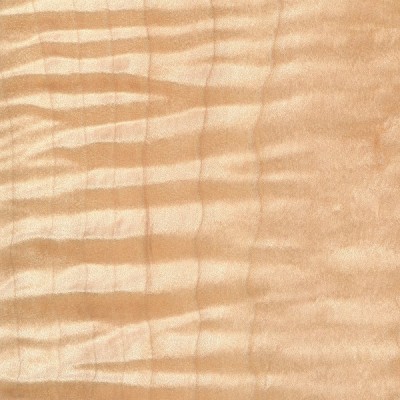
4. Consider the weight and hardness of the wood.
If it’s possible, pick the piece of wood up and get a sense of its weight, and compare it to other known wood species. Try gouging the edge with your fingernail to get a sense of its hardness. If you have a scale, you can take measurements of the length, width, and thickness of the wood, and combine them to find the density of the wood. This can be helpful to compare to other density readings found in the database. When examining the wood in question, compare it to other known wood species, and ask yourself these questions:
Is the wood dry?
Wood from freshly felled trees, or wood that has been stored in an extremely humid environment will have very high moisture contents. In some freshly sawn pieces, moisture could account for over half of the wood’s total weight! Likewise, wood that has been stored in extremely dry conditions of less than 25% relative humidity will most likely feel lighter than average.
How does the wood’s weight compare to other species?
Taking into account the size of the board, how does its weight compare to other benchmark woods? Is it heavier than oak? Is it lighter than pine? Look at the weight numbers for a few wood species that are close to yours, and get a ballpark estimate of its weight.
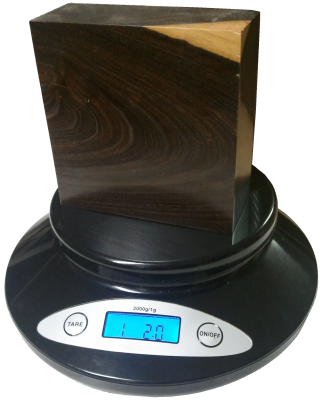
How hard is the wood?
Obviously softwoods will tend to be softer than hardwoods, but try to get a sense of how it compares to other known woods. Density and hardness are closely related, so if the wood is heavy, it will most likely be hard too. If the wood is a part of a finished item that you can’t adequately weigh, you might be able to test the hardness by gouging it in an inconspicuous area. Also, if it is used in a piece of furniture, such as a tabletop, a general idea of its hardness can be assessed by the number and depth of the gouges/dings in the piece given its age and use. A tabletop made of pine will have much deeper dents than a tabletop made of Oak. Additionally, you can always try the “fingernail test” as a rough hardness indicator: find a crisp edge of the wood, and with your fingernail try to push in as hard as you can and see if you’re able to make a dent in the wood.
5. Consider its history.
Many times we forget common sense and logic when attempting to identify wood. If you’ve got a piece of Amish furniture from Pennsylvania, chances are more likely that the wood will be made of something like black walnut or cherry, and not African wenge or jatoba. You might call it “wood profiling,” but sometimes it can pay to be a little prejudiced when it comes to wood identification. Some common-sense questions to ask yourself when trying to identify a piece of wood:
Where did it come from?
Knowing as much as you can about the source of the wood—even the smallest details—can be helpful. If the wood came from a wood pile or a lumber mill where all the pieces were from trees processed locally, then the potential species are immediately limited. If the wood came from a builder of antique furniture, or a boat-builder, or a trim carpenter: each of these occupations will tend to use certain species of woods much more often than others, making a logical guess much simpler.
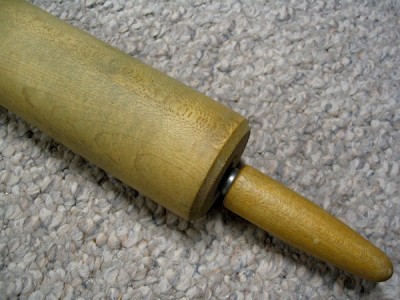
How old is it?
As with the wood’s source, its age will also help in identification purposes. Not only will it help to determine if the wood should have developed a natural patina, but it will also suggest certain species which were more prevalent at different times in history. For instance, many acoustic guitars made before the 1990s have featured Brazilian rosewood backs/sides, yet due to CITES restrictions placed upon that species, East Indian rosewood became a much more common species on newer guitars. (And this is a continuing shift as newer replacements are sought for rosewoods altogether.)
How large is the piece of wood?
Some species of trees are typically very small—some are even considered shrubs—while others get quite large. For instance, if you see a large panel or section of wood that’s entirely black, chances are it’s either painted, dyed, or stained: Gaboon ebony and related species are typically very small and very expensive.
What is the wood’s intended use?
Simply knowing what the wood was intended for—when considered in conjunction with where it came from and how old it is—can give you many clues to help identify it. In some applications, certain wood species are used much more frequently than others, so that you can make an educated guess as to the species of the wood based upon the application where it was used. For instance, in the United States: many older houses with solid hardwood floors have commonly used either red oak or hard maple; many antique furniture pieces have featured quartersawn white oak; many violins have spruce tops; many closet items used aromatic red cedar, and so forth. While it’s not a 100% guarantee, “profiling” the wood in question will help reduce the number of possible suspects, and aid in deducing the correct species.
6. Find the X-Factor.
Sometimes, after all the normal characteristics of a sample have been considered, the identity of the wood in question is still not apparent. In these instances—particularly in situations where a sample has been narrowed down to only a few possible remaining choices—it’s sometimes helpful to bring in specialized tests and other narrower means of identification.
The following techniques and recommendations don’t necessarily have a wide application in initially sorting out wood species and eliminating large swaths of wood species, but will most likely be of use only as a final step in special identification circumstances.
Odor
Believe it or not, freshly machined wood can have a very identifiable scent. When your eyes and hands can’t quite get a definitive answer, sometimes your nose can. Assuming there is no stain, finish, or preservative on or in the wood, quickly sand, saw, or otherwise machine a section of the wood in question, and take a whiff of the aroma.
Although new scents can be very difficult to express in words, many times the scent of an unknown wood may be similar to other known scents. For instance, rosewoods (Dalbergia spp.) are so named for their characteristic odor that is reminiscent of roses. Although difficult to directly communicate, with enough firsthand experience scents can become a memorable and powerful means of wood identification.
Fluorescence
While certain woods can appear basically identical to one another under normal lighting conditions, when exposed to certain wavelengths—such as those found in blacklights—the wood will absorb and emit light in a different (visible) wavelength. This phenomenon is known as fluorescence, and certain woods can be distinguished by the presence or absence of their fluorescent qualities. See the article Fluorescence: A Secret Weapon in Wood Identification for more information.
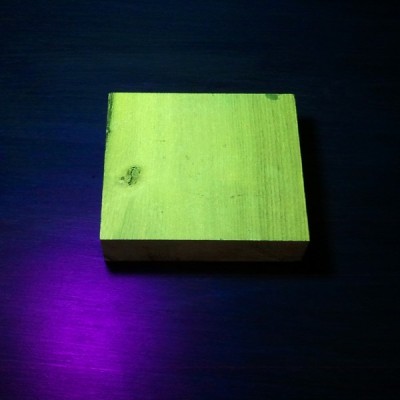
Chemical Testing
There are only a small number of chemical tests regularly used on wood, most of which are very specialized and were developed to help distinguish easily confused species with one another. They work by detecting differences in the composition of heartwood extractives. A chemical substance (called a reagent) is usually dissolved in water and applied to the wood surface: the surface is then observed for any type of chemical reaction (and accompanying color change) that may occur. Two of the most useful are the tests that are meant to separate Red and White Oak, and Red and Hard Maple.
Heartwood Extractives Leachability
Sometimes a wood species will have heartwood extractives that will be readily leachable in water and capable of conspicuously tinting a solution of water a specific color. For instance, the heartwood extractives contained in osage orange (Maclura pomifera) contain a yellowish-brown dye that is soluble in water. (This can sometimes be observed anecdotally when the wood is glued with a water-based adhesive: the glue’s squeeze-out is an unusually vibrant yellow.)
In a simple water extract color test, wood shavings are mixed with water in a vial, test tube, or other suitably small container, and the color of the water is observed after a few minutes. If the heartwood extractives are leachable by water, then a corresponding color change should quickly occur.
In addition to osage orange (Maclura pomifera), merbau (Intsia spp.), and rengas (Gluta spp. and Melanorrhoea spp.) are also noted for their readily leachable heartwood extractives. Because this property is quite uncommon, it can serve to quickly differentiate these woods from other lookalikes.
7. Look at the endgrain.
Perhaps no other technique for accurate identification of wood is as helpful and conclusive as the magnified examination of the endgrain. Frequently, it brings the identification process from a mostly intuitive, unscientific process into a predictable, repeatable, and reliable procedure.
Looking at the endgrain with a magnifier shouldn’t be a mystifying or esoteric art. In many cases, it’s nearly as simple as examining small newsprint under a magnifying glass. There are three components necessary to reap the full benefits contained in the endgrain:
I. A prepared surface.
When working with wood in most capacities, it becomes quickly apparent that endgrain surfaces are not nearly as cooperative or as easily worked as face grain surfaces. However, in this case, it is absolutely critical that a clear and refined endgrain surface is obtained.
For a quick glance of a softwood sample, a very sharp knife or razor blade can be used to take a fresh slice from the endgrain. However, in many denser species, especially in tropical hardwoods, one of the best ways to obtain a clear endgrain view is through diligent sanding. It’s usually best to begin with a relatively smooth saw cut (as from a fine-toothed miter saw blade) and proceed through the grits, starting at around 100, and working up to at least 220 or 320 grit, preferably higher for the cleanest view.
II. The right magnifier.
It need not be expensive, but whatever tool is used to view the endgrain should have adequate magnifying power. In most instances, 10x magnification is ideal, however, anything within the range of 8 to 15x magnification should be suitable for endgrain viewing. (Standard magnifying glasses are typically in the range of 2 to 4x magnification.)
These stronger magnifiers, sometimes called loupes, usually have a smaller viewing area than standard magnifying glasses. Fancier models—with built in lights, or larger viewing surfaces—are available at a premium; but the most basic models are usually only a few dollars.
III. A trained eye.
The third element that constitutes a proper endgrain examination is simply knowing what to look for. In analyzing the patterns, colors, shapes, and spacing of the various anatomical features, there is a veritable storehouse of information within the endgrain—all waiting to be unlocked. Yet, if these elements have not been pointed out and learned, the array of features will simply seem like an unintelligible jumble. The discipline of recognizing anatomical endgrain features is not easily summed up in a few sentences or even a few paragraphs, but it is nonetheless critical to the identification process. To this end, an in-depth look should be given to the various categories, divisions, and elements that constitute endgrain wood identification on the macroscopic level. (In this regard, macroscopic denotes what can be seen with a low-powered, 10x hand lens—without the aid of a microscope—rather than simply what can be seen with the naked eye.) Because the anatomy between softwoods and hardwoods is so divergent, each will be considered and examined separately:Still stumped?
If you have a mysterious piece of wood that you’d like identified, you’ve got a few options for next steps:USDA’s Forest Products Laboratory
You can mail your physical wood samples to the Center for Wood Anatomy Research.
Pros:
- Free
- Professional wood identification
Cons:
- Only available to US citizens
- Slow turnaround times (up to a month or more)
- Limited to three IDs per year
See their Wood ID Factsheet for more info.
Alden Identification Service
You can mail your physical wood samples (even small sections taken from antiques) to Alden Identification Service.
Pros:
- Professional wood identification
- Faster turnaround times (ranging from a few days to a week or two)
Cons:
- Paid service
See their ordering page for more info. (Note that Harry Alden has written several books while at USDA, including both Hardwoods and Softwoods of North America.)
Ask for help online
If the wood ID is merely a curiosity, or non-critical, you can post pictures of the wood in question.
Pros:
- Free
- No need to send physical samples
Cons:
- Greatly limited by the quality of the pictures provided
- Extra work usually required to get adequate clarity in photos
See article of Common US Hardwoods to help find the most commonly used woods.
Get the hard copy
 If you’re interested in getting all that makes The Wood Database unique distilled into a single, real-world resource, there’s the book that’s based on the website—the Amazon.com best-seller, WOOD! Identifying and Using Hundreds of Woods Worldwide. It contains many of the most popular articles found on this website, as well as hundreds of wood profiles—laid out with the same clarity and convenience of the website—packaged in a shop-friendly hardcover book.
If you’re interested in getting all that makes The Wood Database unique distilled into a single, real-world resource, there’s the book that’s based on the website—the Amazon.com best-seller, WOOD! Identifying and Using Hundreds of Woods Worldwide. It contains many of the most popular articles found on this website, as well as hundreds of wood profiles—laid out with the same clarity and convenience of the website—packaged in a shop-friendly hardcover book. 





Why I will no longer be replying to every wood ID request I’ve replied to literally thousands of wood ID requests on this site over the past 13+ years, but as the site’s popularity has grown, so has the time demands for ID on a daily basis. (Contrary to what some may seem to think, I am not some all-knowing wood wizard that can instantly ID your wood. It can actually take me a long time to sift through a lot of different resources.) Over the past few years, my backlog of pending wood species to be added to the… Read more »
Hi Eric, any thoughts about this one?
https://www.facebook.com/OmrysWoodShop/posts/2283070005277645
The label says Leatherwood, but turns out there are multiple completely different wood types called Leatherwood:
https://en.wikipedia.org/wiki/Leatherwood
I am not sure which one (if any at all) I have at hand.
Hard to say as just about all those species tend to be of similar medium weight and relatively bland brown coloration. I’d say if your source was anywhere near Australia, most likely it would just be a uniquely streaked piece of Eucryphia lucida as that is at least available occasionally as a commercial species. To me it looks like a mis-labeled piece of blackheart sassafras or tineo!
I came across a chain carved in central Utah. The end grain has open pores. It is one piece and over 40″ long x about 1″ in diameter. I thought it might be willow. Does anyone know what it might be. I carve and would love to find some. Thanks.
any pictures?
I finally got pictures.
Certainly looks unusual. My only guess would be possibly a large stem of rattan.
Hi to everybody. I’ve got a piece of a log exactly the same of the wood shown in the photos hereby enclosed. But I don’t know the species or the common names of it. I’ll appreciate a lot and I’ll be very grateful if someone is so kind to help me in getting that above mentioned data. I’m a sculptor of wooden works of art. The tree or wood is commonly planted -even in gardens or in sidewalks- in South African cities like Pretoria and Johannesburg. It grows in relatively medium high altitudes land around 1.500 meters or 4,900 feet,… Read more »
here is a 3rd stock blank
here is a 2nd stock blank that we found
We have owned a Gunsmith Business for over 45 years and we purchased a Gunsmith Shop that had closed for some number of years. This shop was a stock builder and he had a lot of stock blanks of different colors and sizes we don’t build stock from start and have no idea what make of wood these are we believe they are of the walnut family. any help with identifying these would be gratefully appreciated.
Does anyone know what type of wood is reddish from one side and brown from the other? I used it for creating a cutting-board for school but I can’t identify it for the presentation!
Eric, thanks for making this resource available. Can you help me identify this wood; it’s a table I purchased in Toronto, Canada. No idea where it was made. Seller said it’s teak….(although it actually does sort of resemble ‘Moulmein teak’ I saw in a YT video).
Leg and top plank shown. Leg is closer to real color, Plank shot is a bit orange. Thanks for any help.
Leg pic didn’t upload and it’s the best shot of the grain!
The color and grain of this definitely looks like walnut. But the stuff in the other picture looked more like mahogany.
Thanks for taking the time to reply. It’s a mystery and will probably remain so. I forgot to mention – the table top seems like an irregular size – 71 1/8 x 35 1/8. And it is very heavy.
I’ll do some searching to find out if it’s common for legs to be of a different material than the legs.
Also should have mentioned that the first pic looks more orange than the table itself, which is more brown.
Does anyone know the type of wood in the parkay flooring below the piece of Walnut. I have the same parkay flooring and am trying to figure out what wood it is before I try to retore them. Thanks in advance.
oak
Hello.
Could anyone help me determine what type of wood this is?
Wood is not painted.
It is covered with linseed oil 2 times.
Any help is appreciated.
Thank.
Hello.
Could anyone help me determine what type of wood this is?
It is very heavy and dense.
I bought several boards 14 feet long. 6 x 3 inch
When I processed it, there was a pleasant smell.
A piece of this wood quickly sinks into the water.
Any help is appreciated.
Thank.
Hi,
Looks like Ipé (Handroanthus spp) . The photos in Wood Database show the Ipé samples as very dark wood (looks like very oxidised) but in fact the wood is much more brown/yellowish.
In the second photo, the brighter grain and color points also to Sucupira (not in WD). Google it for some images
LS
The pleasant smell leads me to lean more toward cumaru, which is very similar to ipe in appearance. Tropical hardwoods can be tough to ID though.
Hi, Can someone please help with identifying what type of wood this table might be. Thank you. Lionel.
Can you tell me what kind of wood these pocket doors are? There are from my 1895 Victorian house in Council Bluffs IA. I was thinking maple? Any tips on staining them. My floors are from that time period as well but I have no idea about type. They are stained golden brown from Duraseal and I was thinking a similar color from Miniwax but I know different types of wood take stain differently…
Looks like quarter sawn oak to me – the strong medullary rays give it away.
Hi, we bought a house in eastern Washington (state) that was built in 1906. Lots of work done over the years. The top third floor (3 small rooms) is covered in old carpet, but I found this uncovered bit in a hidden closet (!) within a closet. Sorry, photo is dark because I couldn’t open the door very far & no natural light could make it in. We’re all set to get laminate put in, but if these floors are good and could be redone… wow. Thanks for your help!
Hi
I’m trying to revive a patio set that came with the house we’re renting. I’ve cleaned and sanded one chair, but don’t want to make another move until I know what kind of wood I’m dealing with. It’s bleached out to a very light yellow-white color.Initially I thought it might be weathered teak, but after cleaning and sanding, I’m not sure. Sticker on bottom says it was made in Indonesia.
Any help would be appreciated.
Heather
Here is the top and mirror part
Hi I’m trying to figure out what this is. Got it in Ohio, was told it might be cherry? Just planed the top to get past the saw marks
Hello Can you Help me identify the the type of wood on this frame? the back of the frame shows the same kind of grain.
Does anyone know what kind of wood this is?
Hi
Can someone help to identify what type of wood this piece is ?
Thanks inadvance
Looks like it’s been coated with a heavy dark stain. Sand it if you really want to know.
Trying to figure out what type of hardwood this is. Believe it’s a hardwood 2” wide pieces varying length. Maybe red oak? It’s not tongue and groove either, nailed down with small nails.
Very hard to tell from the pics, but oak is definitely a possibility, especially with those gigantic rays on the endgrain.
I think this is walnut. However, aim not sure what kind of walnut it is? It’s raw and live edge with the bark still intact. I would be curious as to much it’s worth? It’s 2.5 inches thick, 19 inches wide, and 91 inches long.
This is it. Pictures.
Can someone identify this wood? Possibly maple or birch?
Is this wood stained? Would need to see a closeup of the endgrain to give more info.
Anyone have any idea? It’s a futon a carpenter made for me 22 years ago, and I cant remember what type of wood it is. Only hints I have is it was made in the northeast, it is stained, and it’s relatively heavy. Thanks!
I’d say most likely candidate is stained ash. Could also be oak, but I don’t see any hints of rays in the picture, though it could be just the picture, but no rays suggests ash over oak.
hi,
I’m trying to figure out what wood this china cabinet is made from. thanks
It looks like a lacewood-type of wood, though can’t be sure of the species. There’s a chance it could just be quartersawn sycamore.
thanks Eric
I would like to find out what type of wood this staircase railing is? thanks
It shows the grain pattern of what we would call Virginia walnut (Black walnut) in the UK.
Its was imported only after the British Government removed import tax circa 1721.
It would help alot when people ask a wood question that they state where you are as with Colonial American furniture you can 4 to 6 spieces of timber in one piece
Hi There! I found this in my community wood shop and created a few things out of if. The shop says it only harvests native Coloradan wood. But no one seems to know what it is. Not even sure if this is native to CO. Can you help?
That little bit of flatsawn grain in the middle of the piece (with its very wide and dark earlywood sections) looks very much like a softwood. With any softwood ID, it’s crucial to get a good closeup of the endgrain to check for the presence of resin canals: https://www.wood-database.com/wood-articles/softwood-anatomy/
Thank you Eric. I have some close ups of the resin canals. Does this help at all? Thanks!
Sorry, I can’t quite see enough detail in those pictures to confirm/deny the presence of resin canals. Basically, if there’s a lot of resin canals, it’s probably pine, if there’s less (or none), it’s something else.
Hey Michael! I am not quite sure whether I am correct or not, but if you ask me, I’d say that is Spalted (Maple possibly) Wood. Hope this helps, good luck!
Hi..can someone please help me ID this wood. Dining table with buffet..
Thanks!
Lorri
The top yellow wood looks like a type of satinwood. I would say from looking at these pieces that you should probably get a professional appraiser to look at them in person. They appear to be very high-end pieces.
Can anyone help me identify what wood the moulding on the front of this desk is? I thought it was pine that might have darkened/ reddened with age (I know it was built around 13-14 years ago) – but when comparing it with pine (there’s a bit of pine moulding laying in the bottom of the middle compartment) the grain just looks far too different… It was built in the UK and all the moulding is of the same H/W/D so I’m assuming it’s some kind of ‘standard’ wood that is readily available as stripwood/ moulding? Thanks
It is a softwood, not necessarily pine, but that’s a likely candidate. Depending on the age of the tree and the type of cut for each individual board, the appearance could vary quite a bit.
Sorry..forgot to attach photos. First 2 are End Table and dining table…
Here is the buffet..
Thanks again so much!
Anyone have any idea on what this type of wood is? It is super dense and heavy. The piece in question of course is the dark piece which is sitting on my picnic table. Definitely a hardwood. Came from overseas as a glut between some steel sheets.
Looks like Rosewood to me. I see this color wood all the time on my guitars and it looks a lot like the fingerboards.
The grain reminds me of ekki. https://www.wood-database.com/ekki/ Would need to see a closeup of the endgrain to give further ID info.
After looking at the Ekki database I believe you’re correct. Here is a picture of the end grain.
Now if this indeed Ekki, now comes the part of what should I do with it!
Bingo. Ekki is one of the very few tropical hardwoods with a unique enough grain that it’s fairly easy to ID down to a species level like this. As for what to make, Ekki’s claim to fame is it longevity…
Hello! Can anyone help with identifying what type of wood this bed is?
Thanks!
Can you get a closer picture? Can’t tell from that distance.
Hi all! My pup scratched the heck out of the front door in my rental apartment, conveniently revealing part of the inside for us :)
Is it possible to guess what type of wood this is from the pictures? I couldn’t quite figure it out…
Thanks in advance!
Could anyone help me determine what type of wood this is? This is the underside of a coffee table. Thanks in advance!
Reminds me of douglas fir, though it could be another type of softwood too.
Read through the article, and still can’t tell what kind(if any) my table is. Can anyone help?
looks like quartersawn oak. Those light light colored streaks on the face are called ray fleck, and are pretty unique to oak — at least that type of ray fleck.
I second the oak, as soon as I saw it I thought Oak and then the other guy confirmed what I thought. Nice table its got to be heavy.
Hi, I bought four chairs like in the pics but I am not sure if it’s wood or not. The seller said is ivory oak wood from the legal wood in Indonesia but the weight is very light. Each chair weigh is 5,3 kilos… could anyone help me out how to find out if it’s real wood or not? Thank you
It’s very hard to tell definitively from the pictures. But I will say that it appears the the grain lines in some areas have been rubbed off — it that’s the case, that would be a strong indicator that it’s not real wood, but very hard to tell from the pictures.
possibly walnut.
Can someone kindly tell me what kind of wood this is? Thank you!
I have a 60+ year old homemade table. Can anyone ok tell me what wood this is. I was told it was pecan but I am not for certain it is.
Thats 4 pieces of narrow oak joined together to make a wider piece
yep oak
Diferenciar la jatova de las otras maderas , elondo , ipe , ?
La tabla de 30×6 y la de la izquierda del todo son jatoba , las que no se qué tipo de madera es son las tablas de la medida 25×5 , alguien puede decirme si las demás son elondo o alguna parecida ?
¿¿¿Tal vez, rojo de madera??? ¡¡Lo siento por el retraso / inconveniente!!
Hey! I am NO expert or anything, but I would most definitely rule out both of those options. I would almost have to say: Hickory, Cedar (Atlantic White), or maybe Chestnut. Hope this will help lead you in the right direction!!
Hello – can anyone help me identify what kinda of wood this table is? Are there any characteristics that would help me identify the age of the table?
Yes… it’s a veneer (obviously) and not solid wood but can anyone identify this? It’s close-grained and fairly dense but has the surface characteristics of white oak. Thanks.
Is Palisandro my friend
I’m refinishing a desk that looks like the same kind of wood – very fine-grained. I wondered if it might be mahogany and another reader suggested that, so I think I’m going to assume that mine is mahogany.
This is wood from an old cupboard found in Georgia. Any idea of what the wood is?
anyone know what kind of wood this is ?
Cherry. sap wood is light in color where the heart is red the grain has a dark shading.
Some variety of poplar.
Looks like tulip poplar
LOOKS LIKE SPECKLED MAPLE
bought split firewood from person in Tacoma – said it was locally frown. Any ideas? I want to use for BBQ but want to know what it is first. I have more images…
locally grown. sorry… blackjack or pin oak?
I’d say it’s black walnut but I could be wrong
I have some of the same stuff and it was cut in Columbia county, New York.Did you ever find out for sure what it is?
Hi Bill, while no one could give a 100%, I’m overwhelmingly told it is likely oak
Hi I just bought this flooring at an auction. Does anyone know what it is?
Trying to find out what wood this is,it is kind of Bamboo crossed with pine satin texture,With Holes and knots.i was told it is fast growing,and I kind of think it is from Indonesia,but can’t be sure
SIDE VIEW.
Looks like its spalted
Maybe splayed maple
Thank you very much! I assumed it was spalted, but I just was not sure.
Hey! Can someone please help me identify this piece of wood. I picked it up off the ground near a birch tree; but was mildly surprised to see that it most definitely did not appear to be birch wood. So, I do not really have a clue as to what type of wood this is; any help is very much appreciated!! Thank you!
Jake
Hello, i would like to identify this wood. Can somebody please help me. Thank you
Elizabeth, Possibly American chestnut? The wormholes are common. It is now considered extinct since the chestnut blight wiped it out by the 1930s.
Hi, I was just wondering if you could identify this timber for me. It is from and old church pew, that has now been weathered so much that it has turned completely grey. Any help is appreciated.